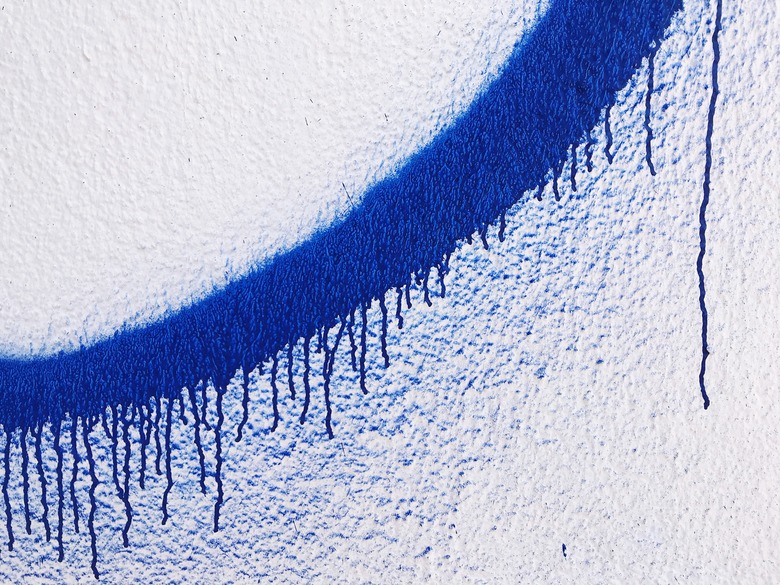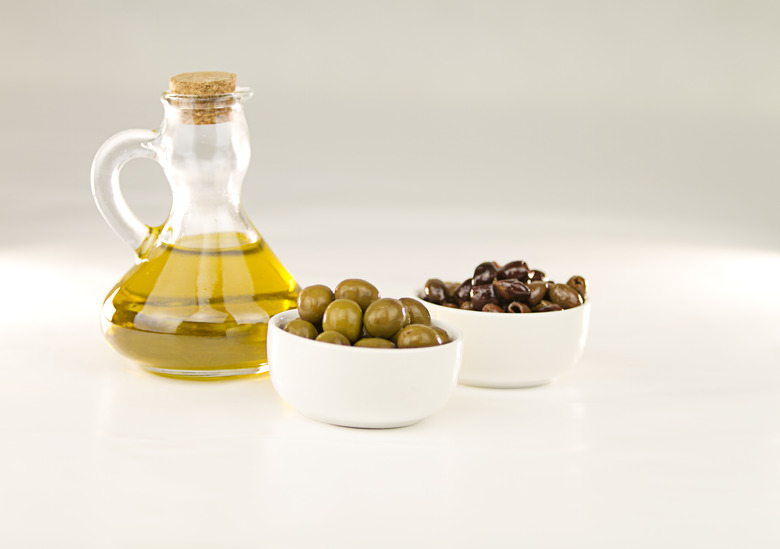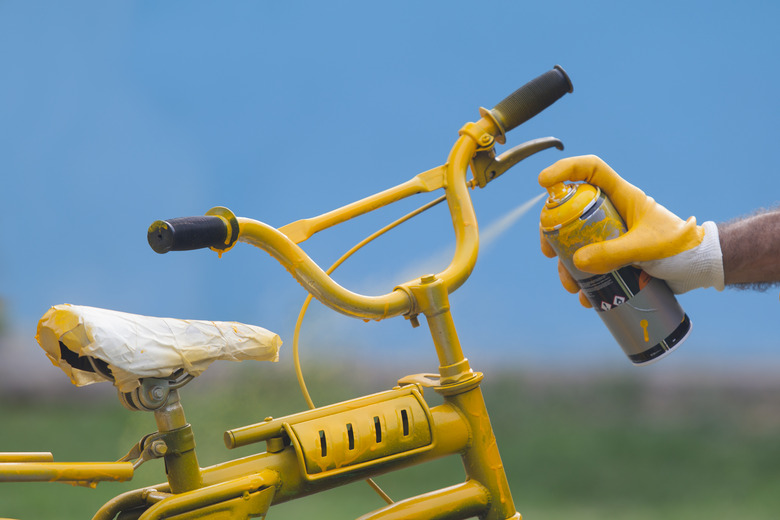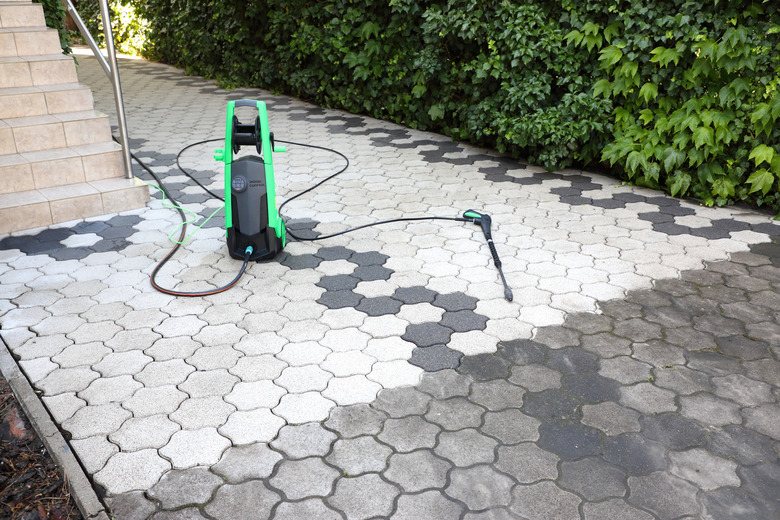How To Remove Spray Paint
When it comes to removing spray paint from typical surfaces around the home, the sooner the cleanup effort happens, the better. This holds true whether dealing with overspray from your own painting project or when removing graffiti from an exterior surface. The best way to remove that paint depends upon the surface. Slick, non-painted surfaces such as bare metal and plastic are relatively easy to clean, while porous surfaces such as brick walls prove a more formidable challenge.
Oil for Oil
Oil for Oil
Many spray paints are oil-based and can be removed, or at least softened, with another form of oil. Any oil from the kitchen, such as cooking, olive or vegetable oil, will do the trick. Petroleum jelly, which is also oil-based, is another option. Since these paint-removal substances are gentle, they're worth trying before reaching for any chemical-based removers that may emit strong fumes. This method is best for skin, plastic, glass, metal, vinyl, sealed wood and non-porous surfaces. Although it may work on porous materials as well, it's not ideal in some cases, as it may be difficult to wash the oil off afterwards.
Things Needed
-
Olive oil, vegetable oil or any cooking oil
-
Clean rags
-
Nylon scrub pad or scrub brush
-
Plastic paint scraper
-
Water
-
Dish soap
Step 1
Pour a small amount of vegetable oil over the affected surface. For a vertical surface, pour the oil onto a clean rag, then press the rag over the paint.
Step 2
Rub the oil into the paint with clean rags or sturdy paper towels. Rub only the area affected by the paint to avoid spreading the oil all over. If the paint has already been on the object for awhile, let the oil sit for 15 minutes or so, or until the paint softens.
Step 3
Wipe the area with a fresh clean rag or paper towel to remove most of the oil. If any paint remains, scrub it with a nylon scrub pad, such as the type used for washing dishes. For a flat surface, a plastic paint scraper also works.
Step 4
Wet another clean rag or paper towel and add a drop of dish soap. Wipe the item down after the paint has been removed to get rid of oily residue. Rinse the rag and wipe the item again to remove soap.
Simple Treatment for Smooth Surfaces
Simple Treatment for Smooth Surfaces
The smoother the non-porous surface, the easier it is to remove spray paint. A graffiti-removing product such as the one made by Goo Gone comes in handy for large areas such as windows, plastic products, sealed stone and metal. It also works on surfaces such as stucco and even concrete, even though these are porous and not always smooth. This type of graffiti remover is not recommended for wood, latex paint or items that may stain easily. Since products vary, read the label thoroughly before use to ensure you've bought the right liquid for the job. Always test the product in an inconspicuous spot before applying over a large area.
Things Needed
-
Goo Gone Graffiti Remover (or similar product)
-
Rubber gloves
-
Safety goggles (or regular glasses/eye protection)
-
Durable paper towels
-
Stiff-bristled scrub brush
-
Garden hose with adjustable nozzle (optional)
Step 1
Spray the graffiti-removing product over the affected area while wearing rubber gloves and eye protection. For a porous surface such as concrete or brick, let the liquid soak in for five minutes or so.
Step 2
If dealing with a smooth surface, wipe the previously sprayed area with paper towels, applying a little pressure to lift the paint and removal product off the surface. For a porous surface, scrub the area with a scrub brush.
Step 3
Rinse the treated area with water. If treating pavement or a brick wall, spray the area with the jet setting on a garden hose.
Step 4
If any spray paint remains, apply repeat the treatment process from the beginning, waiting a little longer for the graffiti remover to work.
Warning
Graffiti-removing products often contain skin and eye irritants. When using them, keep your body as covered as possible to avoid getting any on your skin. Any chemical-based paint remover may contain harmful materials, so always read the label to ensure proper and safe use.
Treatment for Concrete, Stone and Brick
Treatment for Concrete, Stone and Brick
Products used to remove graffiti from public property also work for some exterior household walls, pavement and fences—virtually any surface that can handle low pressure from a pressure washer. This type of product is designed for outdoor application and large-scale paint removal. Although labeled for use on porous unpainted surfaces, these also work on some non-porous and some painted surfaces. A product called Bare Brick Stone & Masonry Remover, from World's Best Graffiti Removal System, is used on walls, skate parks and even playground equipment. A similar product called Wipe Out, from Dumond Chemicals, is used for the same purposes.
Tip
Although such products are labeled as environmentally friendly or even biodegradable, they still contain chemicals that irritate eyes, skin and lungs. Use these products only while wearing eye protection, chemical-resistant gloves and full clothing coverage. At the power washing phase, a full rain suit is ideal.
Things Needed
-
Bare Brick Stone & Masonry Graffiti Remov(or similar graffiti remover)
-
Plastic tub large enough to dip broom bristles
-
Water source
-
Shop broom with synthetic bristles
-
Pressure washer
Step 1
Pour some of the graffiti remover into a plastic tub until the liquid is deep enough coat the tips of the broom bristles. Skip this step if the product came in a spray bottle.
Step 2
Dip the broom into the liquid, then brush it onto the spray paint, whether it's on a horizontal or vertical surface. If using a spray bottle, spray the graffiti remover directly onto the spray paint.
Step 3
Allow the graffiti remover to soak in for several minutes—up to 15 minutes, depending upon the product. Read the label thoroughly, as some recommend applying the product several times, waiting three minutes each time. Others require just one application and a longer wait time.
Step 4
Pressure-wash the treated area at about 1500 PSI, or a low-pressure setting. Choose a fan-style spray and hold the nozzle no closer than 6 inches from the surface. Continue rinsing until the paint has faded. If a pressure washer isn't available, or if a few paint spots remain, brush the affected area with a nylon-bristled scrub brush dipped in water. Hose down the entire treated area, including any areas the graffiti remover may have dripped or trickled onto, using a hose or pressure washer.
Tip
Some graffiti removing products work best in warm weather, but should not be applied on a hot day in full sun, as the product may evaporate quickly. Apply in shade instead. If it's hot outside, wet the treatment area first with a garden hose. If treating a surface in cold weather, it may take a longer time for the removal product to loosen the spray paint. Paint thinner or brake cleaner and a nylon scrub brush can be used in place of graffiti-removal products, but these may contain more harmful chemicals and require more scrubbing when used to remove spraypaint.
Warning
When treating a large area, test the graffiti-removing process in a small area first, then proceed once you determine how well it works. Always use low pressure on the pressure washer to avoid etching or otherwise damaging a delicate surface. If treating a previously painted wall or vinyl siding, for instance, you may wish to skip the pressure washer entirely, opting instead for a scrub brush and garden hose.
References
- City of Cambridge: Graffiti Removal
- Goo Gone: Graffiti Remover
- Pressure Spray Inc.: How to Remove Graffiti From Metal, Wood, Plastic and Masonry Surfaces
- Brad the Painter: How to Remove Spray Paint from All Kinds of Surfaces
- Do It Yourself: How to Remove Car Paint Overspray
- Dumond Chemicals: Watchdog Wipe Out Graffiti



